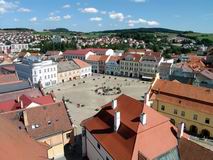
The town Pelhřimov is situated about 35 km east of the town Tábor and about 70 km north-east of the town České Budějovice on the confluence of the small river called Bělá and the Bělka stream in the Českomoravská Vrchovina (Czech-Moravian Uplands), 494 m a.s.l.
The historical centre of the town is a protected reserve.
Three villages or towns with the name Pelhřimov piecemeal originated in the place of the present town.
Originally there was a settlement of unknown name in the place of the St. Vitus' Church. The Prague's bishop Pelhřim founded the new settlement called Pelhřimov in 1224, west of the original one. The new village soon obtained a lot of burghal rights and privileges. It had big problems with water and people left it and it was the reason, why the rights and privileges were assigned to the original village around the St. Vitus' Church (1250). This village became a new town Pelhřimov and the other one was named Starý Pelhřimov (Old Pelhřimov). Pelhřimov burnt down in 1289 and in its surroundings the Prague's bishop founded the new village again. It became a town in 1296 and it was named Pelhřimov - the burnt-out town was connected to this one as a suburb.
Pelhřimov was under the ownership of the Prague's bishops till 1415. During the Hussite Wars it was under command of the Hussite town Tábor. Four governmental assemblies about the organization of the country after the Hussite Wars took place here between 1446 - 1451. The town burnt down three times in the 16th century. These fires started the big development of construction and Pelhřimov became a nice Renaissance town.
During the Thirty Years' War Pelhřimov was plundered by the Swedish soldiery and then it burnt down in 1646 and later in 1766 again. The present look of Pelhřimov is from the Late-Baroque reconstruction in the 18th century.
During the Napoleonic War the Russian soldiery (1800 and 1804) and then the French soldiery (1805 and 1809) captured the town.
The new development (mainly industrial) started in the 20th century.
The town was founded around the square and it has a regular web of streets. The oldest preserved parts of the town are the remains of the town walls with the town gates from the 14th century. The small Renaissance Solná Branka (Saline Gate) in the southern part of the chateau is from the second half of the 16th century.
The dominant feature of the town centre is the St. Bartholomew's Church from the beginning of the 14th century with the Renaissance tower from 1576. There are many Gothic and Renaissance houses with the Baroque gables around the square.
The originally Renaissance chateau from the middle of the 16th century stands in the western part of the square. It is open to the public and it is used as a museum in present.
The oldest sight is the St. Vitus' Church from the 13th century, which stood in the original settlement. It has a Baroque appearance today and it stands in front of the town walls in the St. Vitus' Square.
The Chapel of Our Lady of Sorrow is situated south of the centre. The octagonal building with two towers was built between 1710 - 1712.
Pelhřimov is a hometown of the historian Josef Dobiáš - the author of "The History of the town Pelhřimov", which is one of the broadest monographs of the small town in the world literature. Mikuláš of Pelhřimov, the well-known bishop of the Hussite town Tábor, the actor Lubomír Lipský and his brother, the director and screenwriter Oldřich Lipský, were born in Pelhřimov as well.
The instructional trail Po Stavebních Slozích (Course of Architectural Styles) leads through the town and it acquaints visitors with architectural styles on buildings in the historical centre of the town.
Křemešník hill
small town Nový Rychnov
town Humpolec
town Pacov
Sedlice Dam
Trnava Dam